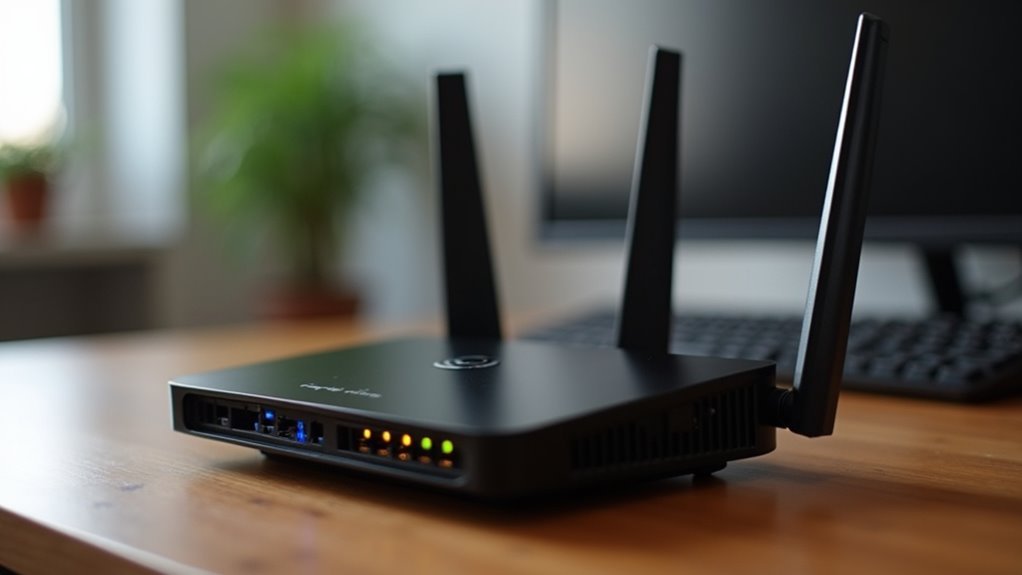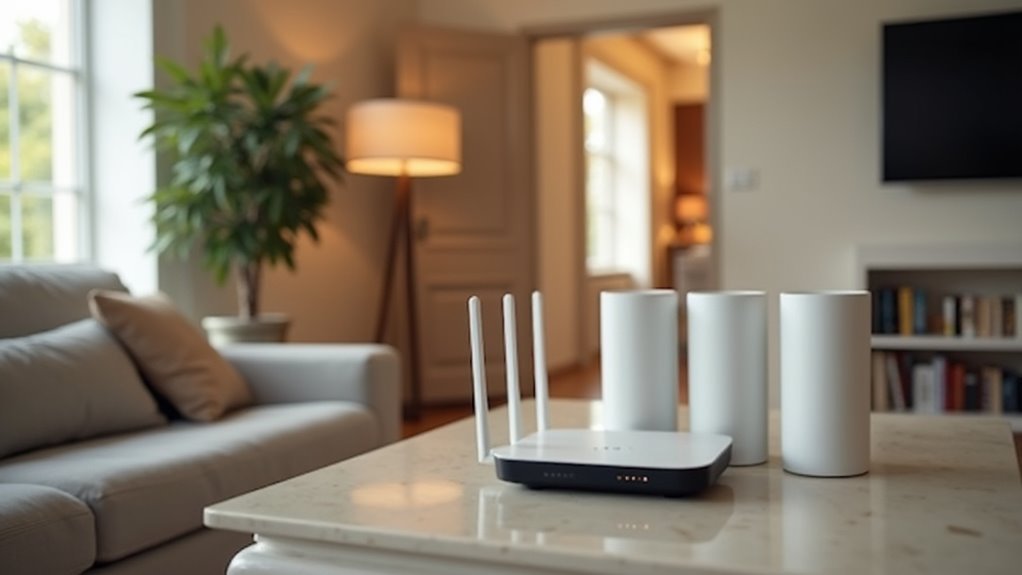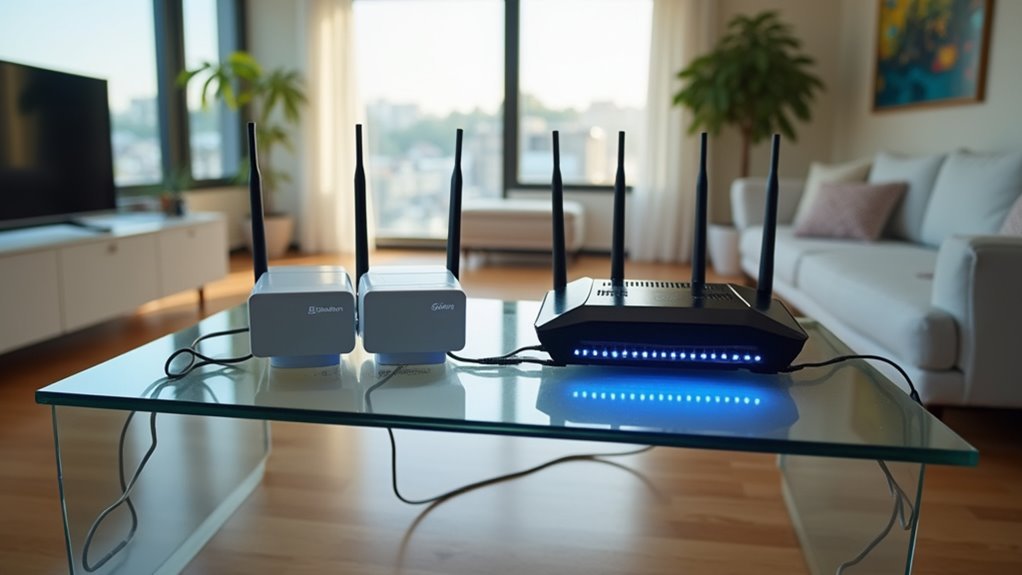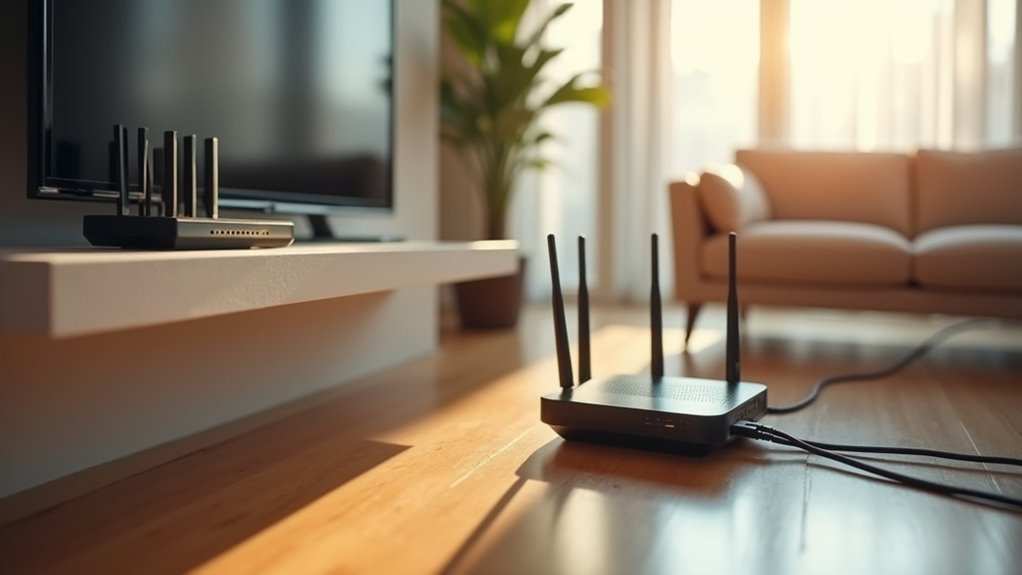You’re standing in your living room, frustrated by another dropped video call because your WiFi signal can’t reach your home office upstairs. Sound familiar? The choice between a traditional router and a mesh system isn’t just about technology—it’s about whether you’ll continue dealing with dead zones and connectivity headaches or finally achieve seamless internet throughout your entire home. Before you make this investment, there’s something vital you need to understand.
Understanding Traditional WiFi Router Technology

When you connect to the internet at home, you’re likely using a traditional WiFi router that serves as your single gateway between your modem and all your devices.
Traditional routers create a wireless network from one central location, broadcasting signals throughout your home. Your home network’s performance depends heavily on your proximity to the router, as signal strength weakens with distance and obstacles like walls or floors.
This setup works well for smaller spaces, but you’ll notice coverage issues in larger homes. Dead zones become problematic areas where your devices struggle to maintain connections.
Traditional routers offer essential features including firewall protection and parental controls while supporting both wired and wireless connections, making them cost-effective solutions for straightforward layouts.
Exploring Mesh WiFi System Architecture
Unlike traditional routers that rely on a single broadcasting point, mesh WiFi systems distribute multiple interconnected nodes throughout your home to create one unified network.
Each node communicates wirelessly with others, eliminating dead zones and ensuring seamless coverage across large areas. You’ll connect all devices under a single SSID, allowing automatic switching to the strongest signal as you move around.
The mesh architecture intelligently manages traffic by prioritizing high-demand devices, maintaining consistent speeds even in congested environments.
These systems support advanced features like automatic firmware updates and WPA3 encryption for enhanced security.
You can easily scale your network by adding nodes without complicated setup processes, making mesh systems more flexible than traditional routers for expanding coverage.
Coverage and Range Comparison

You’ll notice significant differences in how traditional routers and mesh systems handle coverage across your home’s square footage.
Traditional routers create dead zones and weak signals as you move farther from the single access point, while mesh networks eliminate these problem areas through strategically placed nodes.
Whether you’re dealing with a sprawling single-story layout or multiple floors, understanding these range limitations will help you choose the right solution for seamless connectivity throughout your space.
Range Limitations Explained
Coverage represents one of the most significant differences between mesh WiFi systems and traditional routers.
Traditional routers face inherent range limitations that create dead zones in homes exceeding 3,000 square feet. You’ll experience weak signals when walls, furniture, and distance obstruct your router’s single access point. These coverage gaps force you to deal with dropped connections and slow speeds in certain areas.
Mesh WiFi systems eliminate these problems through multiple nodes strategically placed throughout your home. Each node maintains a strong signal by working together as a unified network.
You won’t encounter dead zones because the system automatically connects your devices to the nearest, strongest node. Unlike traditional routers that broadcast from one fixed location, mesh networks adapt coverage to your home’s unique layout and obstacles.
Dead Zone Solutions
When dead zones plague your home network, mesh WiFi systems provide extensive solutions that traditional routers can’t match. Traditional routers operate from single access points, causing signal strength to weaken with distance and obstacles.
Mesh systems solve this by creating intelligent networks that automatically enhance traffic across multiple nodes.
Here’s how mesh systems eliminate dead zones:
- Multiple access points create overlapping coverage bubbles throughout your home
- Smart device switching connects you to the nearest node for peak performance
- Seamless coverage maintains strong connections as you move between rooms
- Superior scalability handles multiple devices without speed degradation
While WiFi extenders offer some dead zone relief, they often reduce speeds and create network complications.
Mesh systems deliver consistent, seamless coverage that adapts to your home’s unique layout and obstacles.
Multi-Story Home Coverage
Multi-story homes present unique networking challenges that expose the fundamental limitations of traditional routers. When you’re dealing with multiple floors, traditional routers struggle to penetrate through ceilings and walls, creating frustrating dead zones in upper levels or distant rooms.
Mesh WiFi systems solve this problem by deploying multiple nodes throughout your home, ensuring consistent signal strength on every floor. You’ll experience seamless connectivity as the system automatically connects your devices to the nearest node.
| Feature | Traditional Routers | Mesh WiFi Systems |
|---|---|---|
| Coverage Area | Limited to ~2,000 sq. ft. | Up to 10,000 sq. ft. |
| Multi-floor Performance | Weak upper floor signals | Consistent throughout floors |
For homes over 3,000 square feet, mesh systems provide superior coverage without requiring additional extenders that compromise speed.
Performance and Speed Analysis

Although traditional routers can deliver impressive speeds when you’re close to the device, mesh systems excel at maintaining consistent performance across your entire home.
Traditional routers often struggle with speed degradation as distance increases, while mesh routers automatically distribute traffic efficiently.
Performance tests reveal interesting trade-offs between these technologies:
- Close-range speed: Traditional routers like the Synology WRX560 often outperform mesh systems like Eero 6 when you’re near the main unit.
- Distance performance: Mesh routers maintain higher speeds at greater distances through strategic node placement.
- Multiple devices: Mesh systems handle peak traffic loads more effectively, ensuring connectivity stability across all connected devices.
- Traffic prioritization: Mesh networks automatically optimize bandwidth for high-demand devices, improving overall WiFi coverage.
Cost Breakdown and Budget Considerations
Budget plays an essential role in determining whether mesh WiFi or traditional routers make sense for your home network setup.
Traditional routers offer the most budget-friendly approach, ranging from $35 to $350, making them cost-effective for smaller homes with basic connectivity requirements. You’ll find basic models starting around $60, which often suffice without additional equipment.
Traditional routers provide the most affordable networking solution, with basic models starting at just $60 for smaller homes.
Mesh systems require a higher initial investment, typically costing $130 to $350 for two to three nodes. Lower-end mesh options average $170, while premium models reach $300.
Your coverage needs directly impact total costs, as larger homes may require additional nodes, increasing expenses further.
Evaluate your specific coverage needs and number of connected devices carefully. Traditional routers provide better value for minimal connectivity demands, while mesh systems justify their cost in larger spaces.
Setup Process and Installation Requirements
When you’re ready to set up your new network equipment, you’ll find that mesh systems and traditional routers take distinctly different approaches to getting you online.
Mesh WiFi systems guide you through installation using intuitive smartphone apps that simplify node placement, while traditional routers typically require you to navigate web-based admin panels with more technical configuration steps.
Understanding these setup differences will help you choose the option that matches your technical comfort level and installation preferences.
Initial Setup Steps
Since you’re choosing between mesh WiFi and traditional routers, understanding their setup processes can help you decide which option fits your technical comfort level.
Traditional routers require a simple plug-and-play approach, while mesh WiFi systems offer more thorough coverage through strategic node placement.
Here are the initial setup steps for each system:
- Traditional routers: Connect your router to the modem using an Ethernet cable, then configure settings through a web interface.
- Mesh systems: Use the companion app to guide node placement and guarantee each unit connects to your main node.
- Strategic positioning: Place your primary router or main node centrally in your home for best coverage.
- Network configuration: Set up WiFi passwords and network names to minimize dead zones and maximize performance.
Installation Configuration Requirements
Beyond the basic setup steps, you’ll need to meet specific configuration requirements that differ considerably between these two WiFi solutions.
Traditional routers demand more technical configuration knowledge, requiring you to access admin panels through web browsers and manually adjust network settings. In contrast, mesh network installation simplifies this process through intuitive smartphone app guidance that walks you through each configuration step.
For ideal signal strength, you’ll position your main mesh router near your internet entry point, then strategically place additional nodes throughout your home.
The smartphone app automatically handles most technical setup requirements, eliminating complex manual configuration. Traditional routers often intimidate less tech-savvy users with their detailed configuration menus, while mesh systems prioritize user-friendly installation that anyone can complete successfully.
Ethernet Port Support and Wired Connections
While wireless connectivity gets most of the attention in router discussions, your wired connections often matter just as much for peak network performance. Traditional routers typically limit you with fewer Ethernet ports, constraining multiple devices that need stable connections.
Mesh routers offer superior flexibility by distributing ports across nodes throughout your home, ensuring high-speed access wherever you need it.
- Strategic placement: Position mesh nodes near devices requiring wired connections for peak performance
- Enhanced capacity: Multiple nodes mean more available Ethernet ports for your expanding device collection
- Wired backhaul support: Premium mesh systems like NETGEAR Orbi reduce wireless congestion through direct node connections
- Gaming advantage: Wired connections deliver lower latency and faster speeds for streaming and gaming devices
Managing Challenging WiFi Environments
When your home features thick walls, metal structures, or sprawling square footage, WiFi signals face their toughest battles. Traditional routers often struggle in homes over 3,000 square feet, creating dead zones where internet access becomes unreliable or non-existent.
Masonry walls, metal garage fixtures, and poorly placed ISP drops compound these connectivity issues, particularly affecting basements and attics.
Mesh WiFi systems excel in challenging environments by deploying multiple nodes that communicate automatically to strengthen signal coverage throughout your property. This distributed approach eliminates dead zones and reduces delays, making them ideal for smart home devices that require consistent connectivity.
Unlike single-point traditional routers, mesh networks extend reliable WiFi coverage to outdoor areas and separate units, ensuring you maintain strong signal strength across your entire property.
WiFi 7 Technology Advancements
As WiFi 7 technology reshapes wireless networking, you’ll discover capabilities that surpass previous generations by considerable margins. This advancement delivers exceptional network efficiency through innovative features that transform how your devices connect and communicate.
WiFi 7’s breakthrough technologies include:
- Quad-band support – Creates three separate networks for home, guest, and smart devices, optimizing performance across different device types.
- Enhanced data transfer speeds – 320MHz channels and 4096 QAM deliver markedly faster connections for bandwidth-intensive applications.
- Multi-Link Operation – Allows devices to connect across multiple bands simultaneously, reducing congestion and improving traffic flow.
- Advanced security – Features NETGEAR Armor WPA3 encryption with automatic firmware updates protecting against vulnerabilities.
You’ll benefit from increased simultaneous connections, making WiFi 7 perfect for homes with numerous smart devices requiring reliable, high-performance connectivity.
Smart Home Device Integration
Since modern homes contain dozens of connected devices, your choice between mesh WiFi and traditional routers greatly impacts how well these smart systems perform together.
Mesh WiFi systems excel at smart home device integration by eliminating dead zones through multiple nodes that blanket your entire home. You’ll enjoy seamless connectivity across all devices, from smart thermostats to security cameras.
Traditional routers often struggle in larger homes, creating connectivity issues for devices in distant rooms.
Mesh systems offer centralized management through intuitive mobile apps, letting you monitor and control everything from one interface. Many support advanced protocols like Zigbee and Z-Wave, while some include built-in voice assistant support for hands-free automation control throughout your connected home.
Security Features and Network Protection
Beyond smart home connectivity, protecting your network from cyber threats becomes increasingly critical as hackers develop more sophisticated attack methods.
Mesh WiFi systems typically offer superior security features compared to traditional routers, providing enhanced network protection through advanced technologies.
Modern mesh systems often include:
- WPA3 encryption – The latest security standard offering stronger protection than WPA2 found in older traditional routers
- Automatic firmware updates – Patches security vulnerabilities without manual intervention, keeping your network current
- Guest networks – Isolates visitor devices from your main network, protecting sensitive data and connected devices
- Advanced monitoring – Real-time network activity tracking with parental controls and device prioritization features
These extensive security features make mesh WiFi particularly attractive for households prioritizing robust network protection.
Scalability and Future Expansion Options
When you’re planning your home network, you’ll want to contemplate how easily you can expand coverage as your needs grow.
Mesh systems let you add new nodes within minutes while maintaining seamless connectivity, but traditional routers often require complete replacement or complex extender setups that can slow your speeds.
Your choice between these technologies will determine whether you can effortlessly adapt to future smart home devices and coverage demands or face costly upgrades down the road.
Adding Network Nodes
As your home’s internet demands grow, mesh WiFi systems offer unmatched flexibility through their modular design. You can start with a basic two-node setup and expand incrementally as needed, eliminating dead zones without compromising performance.
Each network node communicates with others to create a seamless network that maintains consistent speeds across all devices.
Unlike traditional routers that require separate extenders which often reduce speed, mesh WiFi systems preserve full bandwidth throughout your expanded coverage area.
Here’s how adding nodes benefits you:
- Start small and expand gradually based on your specific coverage needs
- Maintain high-speed connectivity across all devices without performance drops
- Use companion apps to easily add and manage new nodes
- Accommodate future technology demands and growing internet usage
Future Technology Upgrades
The rapid pace of technological advancement makes future-proofing your network investment a top priority.
You’ll find that mesh systems excel at future-proofing connectivity compared to traditional routers. When advancements in WiFi technology like WiFi 7 emerge, mesh systems typically integrate new protocols more seamlessly than their traditional counterparts.
You’ll benefit from automatic firmware updates in modern mesh networks, ensuring your system stays secure and current without manual intervention. This contrasts with traditional routers that often require manual updates you might forget or delay.
Mesh systems also provide centralized app management, letting you monitor and optimize network performance as technology evolves.
You can easily adjust settings and accommodate new devices through intuitive interfaces, making long-term network management considerably more manageable than traditional router configurations.
Use Case Scenarios for Different Home Types
Choosing between mesh WiFi and traditional routers depends heavily on your home’s unique characteristics and connectivity needs. For smaller homes under 1,500 sq. ft., a traditional router typically provides reliable WiFi at budget-friendly prices starting from $35.
For homes under 1,500 square feet, traditional routers offer reliable coverage at wallet-friendly prices starting around $35.
The router vs mesh WiFi better decision shifts when you’re dealing with larger homes over 3,000 sq. ft., where mesh systems excel at eliminating dead spots through strategically placed nodes.
Consider these scenarios when making your choice:
- Small apartments or condos: Traditional routers deliver adequate internet speeds and coverage
- Multi-story or sprawling homes: Mesh networks guarantee seamless connectivity throughout challenging layouts
- Heavy streaming households: Mesh WiFi better manages multiple high-bandwidth devices simultaneously
- Homes with signal-blocking materials: Mesh systems overcome brick or concrete construction barriers effectively
Making the Right Choice for Your Home
Understanding these scenarios helps narrow your options, but several key factors will determine which solution fits your specific situation best.
First, assess your home layout and square footage. If you’ve got a smaller space under 3,000 square feet, Traditional Routers often provide excellent performance at lower costs.
However, homes experiencing dead zones or requiring internet access across multiple floors benefit considerably from Mesh WiFi systems.
Consider your speed requirements and budget constraints. While standalone routers can deliver high speeds in ideal conditions, they’re limited by distance and obstacles.
Mesh WiFi maintains consistent performance throughout larger areas but costs more upfront.
Evaluate your household’s connectivity demands, technical comfort level, and whether you prioritize easy setup over maximum performance in centralized locations.
Frequently Asked Questions
Should I Get a Mesh Router or Regular Router?
You should choose a mesh router if your home’s over 3,000 square feet or has many devices. Pick a traditional router if you’re in a smaller space and want lower costs.
What Are the Downsides of a Mesh Router?
You’ll face higher upfront costs, complex setup processes, potential gaming lag from wireless node connections, overkill for smaller spaces, and additional failure points that can impact your entire network’s performance.
What Must Be Avoided in a Mesh Network?
You must avoid placing nodes too far apart, blocking them with thick walls, overcrowding single nodes with devices, positioning your primary node poorly, and neglecting firmware updates that maintain security.
Does a Mesh Wifi System Replace a Router?
Yes, a mesh WiFi system replaces your traditional router by providing distributed coverage through multiple nodes. However, you’ll still need your modem to connect the mesh system to the internet.





Leave a Reply